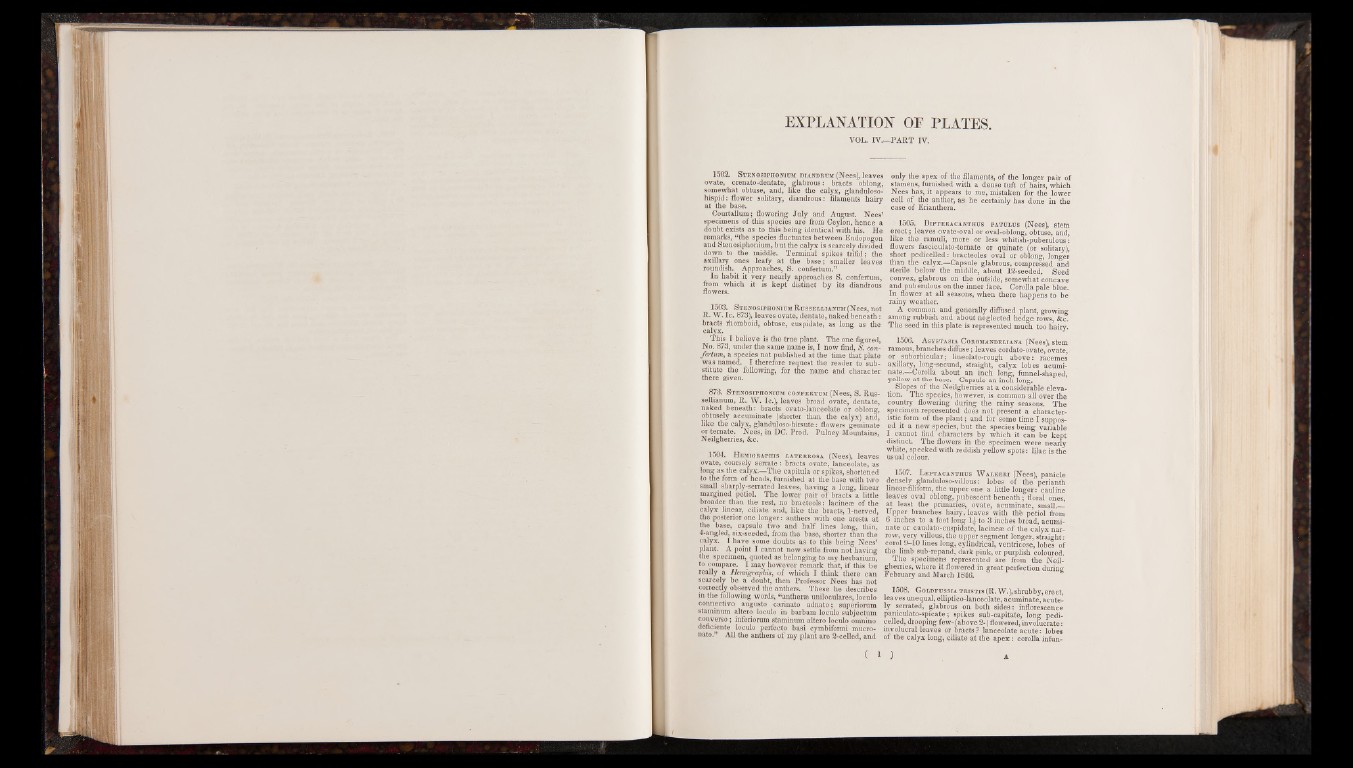
EXPLANATION OP PLATES.
VOL. IV.—PART IV.
1502. Stenosiphonium diandrum (Nees), leaves
ovate, crenato-dentate, glabrous: bracts oblong,
somewhat obtuse, and, like the calyx, glanduloso-
hispid: flower solitary, diandrous: filaments hairy
at the base.
Courtallum; flowering July and August. Nees’
specimens of this species are from Ceylon, hence a
doubt exists as to this being identical with his. He
remarks, “the species fluctuates between Endopogon
and Stenosiphonium, but the calyx is scarcely divided
down to the middle. Terminal spikes trifid; the
axillary ones leafy at the base; smaller leaves
roundish. Approaches, S. confertum.”
In habit it very nearly approaches S. confertum,
from which it is kept distinct by its diandrous
flowers.
1503. Stenosiphonium Russellianum (Nees, not
R. W. Ic. 873), leaves ovate, dentate, naked beneath:
bracts rhomboid, obtuse, cuspidate, as long as the
calyx.
This I believe is the true plant. The one figured,
No. 873, under the same name is, I now find, & confertum,
a species not published at the time that plate
was named. I therefore request the reader to substitute
the following, for the name and character
there given.
873. Stenosiphonium confertum (Nees, S. Russellianum,
R. W. Ic.), leaves broad ovate, dentate,
naked beneath: bracts ovate-lanceolate or oblong,
obtusely accuminate (shorter than the calyx) and,
like the calyx, glanduloso-hirsute: flowers geminate
or temate. Nees, in DC. Prod. Pulney Mountains,
Neilgherries, &c.
1504. Hemigraphis jlatebrosa (Nees), leaves
ovate, coarsely serrate: bracts ovate, lanceolate, as
long as the calyx.—The capitula or spikes, shortened
to the form of heads, furnished at the base with two
small sharply-serrated leaves, having a long, linear
margined petiol. The lower pair of bracts a little
broader than the rest, no bracteols: lacineas of the
calyx linear, ciliate and, like the bracts, 1-nerved,
the posterior one longer: anthers with one aresta at
the base, capsule two and half lines long, thin,
4-angled, six-seeded, from the base, shorter man the
calyx. I have some doubts as to this being Nees’
plant. A point I cannot now settle from not having
the specimen, quoted as belonging to my herbarium,
to compare. I may however remark that, if this be
really a Hemigraphis, of which I think there can
scarcely be a doubt, then Professor Nees has not
correctly observed the anthers. These he describes
in the following words, “anther* uniloculares, loculo
connectivo augusto carinato adnato; superiorum
staminum altero loculo in barbam loculo subjectum
converso; inferiorum staminum altero loculo omnino
deficiente loculo perfecto basi cymbiformi mucro-
nato.” All the anthers of my plant are 2-celled, and
only the apex of the filaments, of the longer pair of
stamens, furnished with a dense tuft of hairs, which
Nees has, it appears to me, mistaken for the lower
cell of the anther, as he certainly has done in the
case of Erianthera. -•
- 1505. Dipteracanthus patulus (Nees), stem
erect; leaves ovate-oval or oval-oblong, obtuse, and,
like the ramuli, more or less whitish-puberulous:
flowers fasciculato-temate or quinate (or solitary),
short pedicelled: bracteoles oval or oblong, longer
than the calyx.—Capsule glabrous, compressed and
sterile below the middle, about 12-seeded. Seed
convex, glabrous on the outside, somewhat concave
and pub erulous on the inner face. Corolla pale blue.
In flower at all seasons, when there happens to be
rainy weather.
A common and generally diffused plant, growing
among rubbish and about neglected hedge rows, &lc.
The seed in this plate is represented much too hairy.
1506. Asystasia Coromandeliana (Nees), stem
ramous, branches diffuse; leaves cordato-ovate, ovate,
or sub orbicular; lineolato-rough above: racemes
axillary, long-secund, straight, calyx lobes acuminate.—
Corolla about an inch long, funnel-shaped,
yellow at the base. Capsule an inch long.
Slopes of the Neilgherries at a considerable elevation.
The species, however, is common all over the
country flowering during the rainy seasons. The
specimen represented does not present a characteristic
form of the plant; and for some time I supposed
it a new species, but the species being variable
I cannot find characters by which it can be kept
distinct The flowers in the specimen were nearly
white, specked with reddish yellow spots: lilac is the
usual colour.
1507. Leptacanthus Walkeri (Nees), panicle
densely glanduloso-villous: lobes of the perianth
linear-filiform, the upper one a little longer: cauline
leaves oval oblong, pubescent beneath; floral ones,
at least the primaries, ovate, acuminate, small.—
Upper branches hairy, leaves with thfe petiol from
6 inches to a foot long 1^ to 3 inches broad, acuminate
or caudato-cuspidate, lacine* of the calyx narrow,
very villous, the upper segment longer, straight:
corol 9-10 lines long, cylindrical, ventricose, lobes of
the limb sub-repana, dark pink, or purplish coloured.
The specimens represented are from the Neilgherries,
where it flowered in great perfection during
February and March 1846.
1508. Goldfussia tristis (R. W.), shrubby, erect,
leaves unequal, elliptico-lanceolate, acuminate, acutely
serrated, glabrous on both sides: inflorescence
paniculato-spicate; spikes sub-capitate, long pedicelled,
drooping few- (above 2-) flowered, involucrate:
involucral leaves or bracts ? lanceolate acute: lobe*
of the calyx long, ciliate at the ap ex : corolla infun